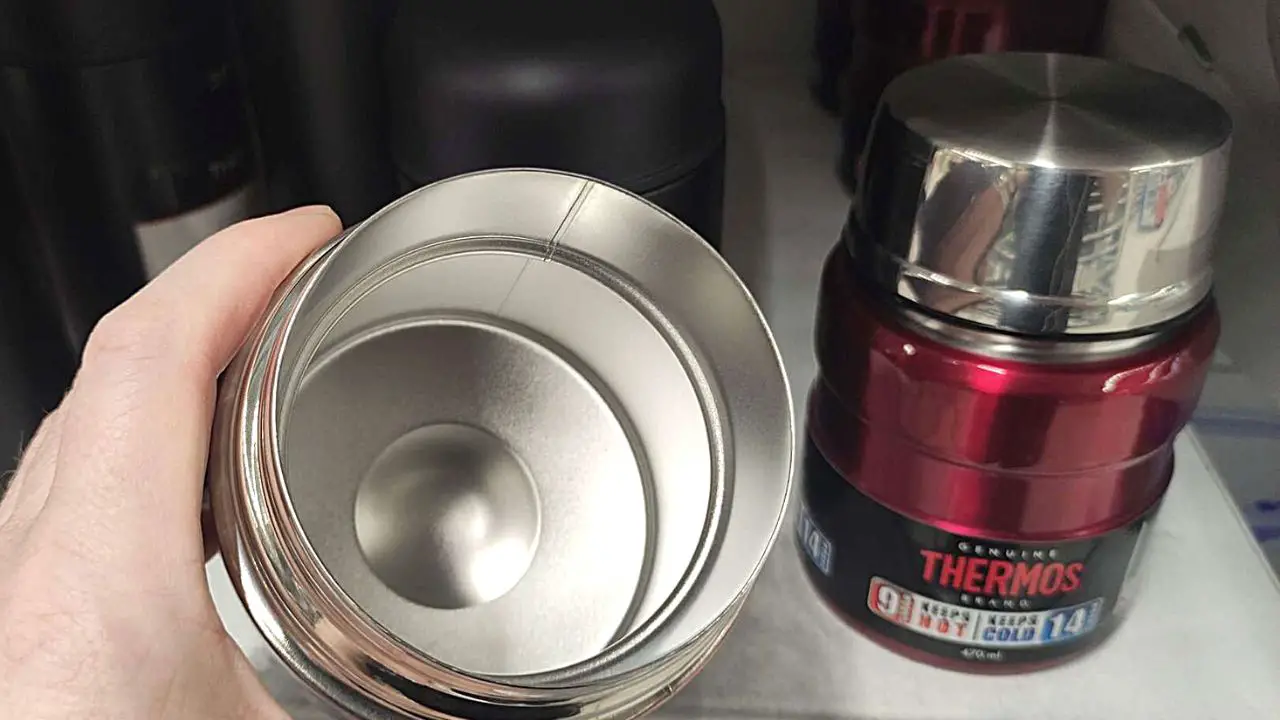Thermos, also known as vacuum flask is such a great invention. Isn’t it? Thank you James Dewar for inventing it over a hundred years ago. This simple container, specifically designed to keep your food and drinks hot or cold is one of the most used storage containers in my kitchen, or should I say, outside of my kitchen.
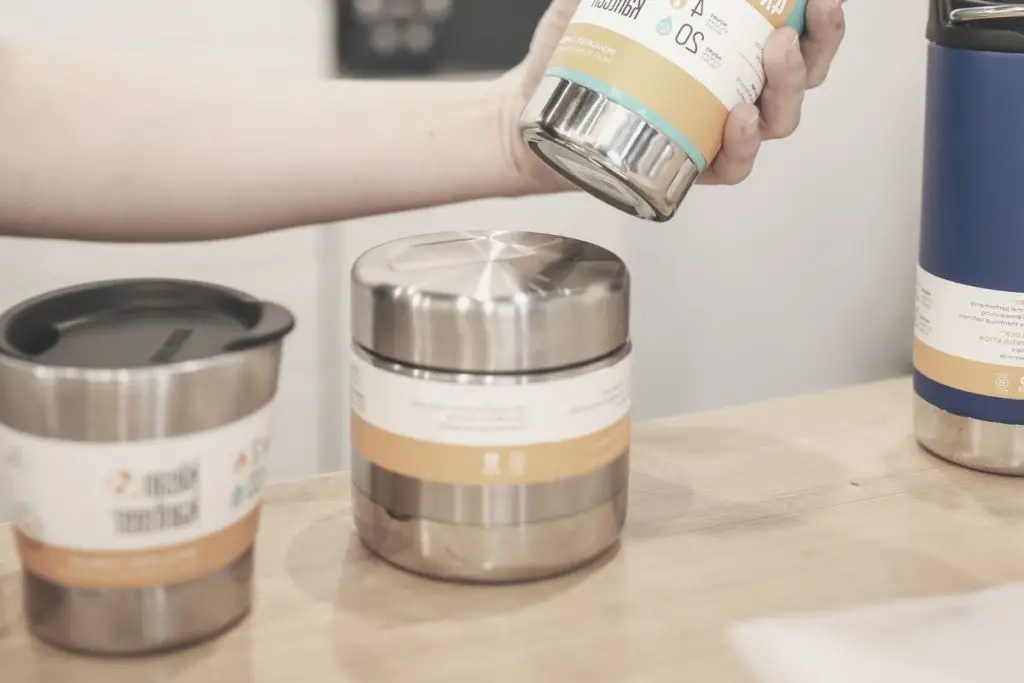
As you probably have noticed, I am very particular about my food and diet, so with this useful gadget, there is no need for me to give up or buy food when I go outside. I can just as easily use my thermos to keep my healthy homemade food nice, warm, and fresh for hours and hours.
However, if this is the first time you are using a thermos there are certain tricks and tips you should know beforehand to ensure your food remains hot, safe, delicious, and in tip-top condition from preparation until it’s time to eat.
Curious? Here is everything you need to know about how to use a thermos for hot food.
Thermos Food Safety
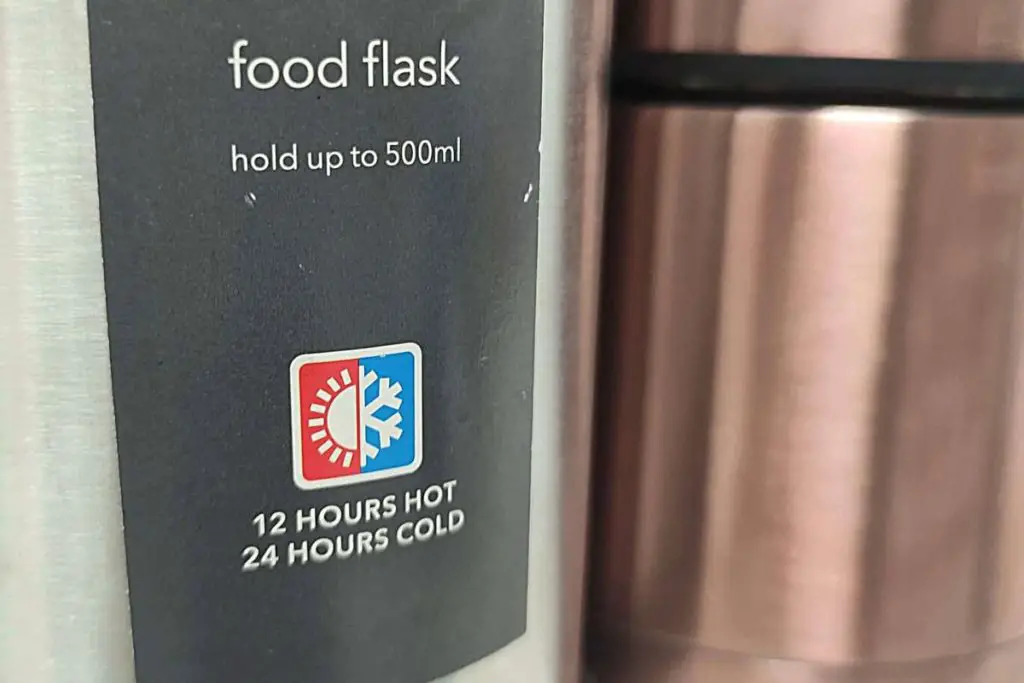
The only quintessential aspect of thermos food safety is to ensure the content remains at the intended temperature without any drastic changes. The goal is to keep your thermos’ internal temperature above 140°F (60°C) for as long as possible, as this will prevent any bacterial proliferation (growth) within the food [1].
Of course, this means that you should never eat from your thermos if the temperature of the food you stored inside has dropped to lukewarm or even cold.
TAP ON IMAGE TO VIEW PRICE
To ensure optimal thermos food safety, and avoid getting sick, always follow the manufacturer’s directions regarding the hours your food will remain hot and safe to eat. The time provided by the manufacturer is usually quite accurate and gives you a good idea of how long the thermos can lock the heat in and maintain a steady temperature.
From your end, you must always ensure your thermos is clean and hot enough before even storing the food inside. Likewise, make sure to eat all food at once after opening the thermos–any leftovers are going to lose heat quite fast, therefore at risk of growing harmful bacteria that could cause food poisoning.
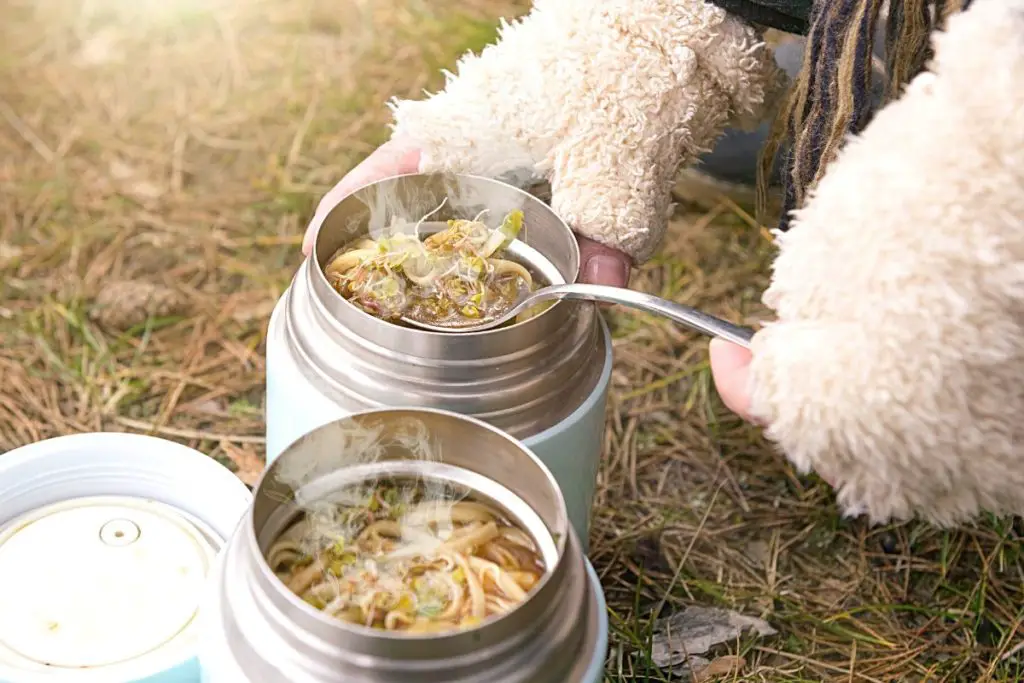
To maximize the time your food can stay hot, what are the best and worst food to keep in a thermos, and some useful tips, check out these frequently asked questions below.
What Is The Best Thermos To Use For Hot Food?
It depends on the lifestyle of the person using it. However, a good rule of thumb is selecting a vacuum insulated thermos made of lightweight material like food-grade stainless steel, with a smooth inner surface and a wide mouth. Likewise, make sure it explicitly states that it can preserve high temperatures for at least six hours.
For your comfort, a thermos with a wide mouth will always be much easy to handle since it makes it easier to pour the content inside or clean after eating. Likewise, a smooth inside surface guarantees that no food leftovers can get stuck and create bacteria.
On the other hand, there are usually five to six hours between the early morning and noon. Therefore getting a thermos that guarantees temperature preservation for such a timeframe is a good failsafe to keep your food warm until lunch.
How To Use A Thermos For Hot Food?
The most crucial step is to guarantee the thermos is very hot before filling it up with the food for the day, as this ensures minimal temperature loss for as many hours as possible.
To prewarm the flask, your best bet is to open your clean thermos and pour boiling water inside, careful not to burn yourself. You can let it warm up on the counter for a few minutes while you are preparing the food to store in it.
Once the food is ready and the thermos is warm enough, pour the water out and fill it back again with the steaming hot food, making sure to close the lid as fast as possible to prevent heat loss.
How To Use A Thermos For Coffee?
The essential step is to ensure the thermos is already hot before pouring the freshly-brewed coffee, as this guarantees the beverage will remain warm for hours.
Once again, the boiling water trick works like a charm—make sure to pour boiling water inside the thermos and let it sit for a few minutes to ensure the vessel absorbs the heat. Once warm enough, remove the water and pour the freshly-brewed coffee, closing the lid immediately.
A word of advice—be careful drinking it shortly after pouring it into the thermos, you could get burnt if you drink it directly from the mouthpiece. After all, a good thermos can keep the temperature near boiling point for a long time. Another alternative is to carry a portable mug and serve your beverage there, letting it cool for a bit before drinking.
Also, add milk and sugar later when drinking it and not before storing it in the thermos.
How Long Does A Thermos Keep Food Hot?
On average, most thermoses claim to keep food hot for a minimum of six hours. However, it depends on the specifications of each brand since the material, size, and design can affect the timeframe.
For example, certain brands claim to keep your food’s temperature intact for nearly 24 hours, while others remain between the 6-8 hour range. Likewise, if you heat your thermos beforehand with boiling water and add your food straight after cooking it, you can drastically increase its heat retention.
But before you go out, keep in mind that according to the U.S. Department of Agriculture, bacteria thrive in temperatures between 40°F and 140°F (4.4°C and 60°C), so make sure your perishable food does not drop to that range and once it does, the food should be discarded after two hours [2].
What Is The Best Hot Food To Pack In A Thermos?
The best hot meals to carry around in a thermos have high water content and are somewhat dense. These characteristics maximize heat preservation, making these meals hot and safe to eat for much longer.
Naturally, soups and stews remain the best option, as they can remain hot for hours regardless of the thermos’ quality. However, other creative options are curry, oats and other grain porridge, beans and lentils, and vegetables, amongst other dishes.
Just keep in mind that thermos don’t heat food but it only has insulating technology that prevents heat loss, but some of it is still inevitable—as the day goes by, the food will slowly lose some heat. If you do not eat your meal fast enough, or if your thermos lost plenty of heat at once, you may risk food poisoning.
Can You Put Rice In A Thermos?
You can keep freshly cooked rice in a thermos and it is generally safe as long as you follow the best safety practices above.
However, there are some concerns about the rice and the reasoning is the same behind the general advice not to leave rice at room temperature for more than a couple of hours—spores.
According to England’s National Health Service (NHS), uncooked rice can often contain some spores that are immune to heat. After cooking the rice, the spores can turn into bacteria at room temperature, which may then release toxins and cause food poisoning [3].
To guarantee your rice remains safe, you must ensure the content of your thermos remains above 140°F (60°C) the entire time, which can be done if preheat the vessel with boiling water beforehand. However, it could be a slightly risky choice, as thermoses are better at maintaining hot temperatures with liquidy and dense meals, and regular cooked rice is neither.
Can You Put Scrambled Eggs In A Thermos?
Yes, you can put scrambled eggs in a thermos but since they are a quite delicate and temperature-sensitive meal they can go bad if not kept at a high enough temperature but can also overcook if kept at safe, high temperatures.
The U.S. Food and Drug Administration advises not to leave cooked eggs outside the refrigerator for more than one hour, as letting them sit at room temperature encourages bacteria growth within two hours [4].
Ideally, scrambled eggs are best if eaten immediately after cooking. If you plan to store them for later, make sure they don’t stay in the temperature danger zone for more than two hours and are ideally kept over 165°F (74°C).
Perfectly cooked scrambled eggs are a delicate, moist, and fluffy meal. Subsequently, if kept that hot for too long, they will end up rubbery and overcooked.
However, other egg dishes are perfectly safe inside a thermos as long as they remain hot.
Can You Put Chicken In A Thermos?
Chicken is safe to put on a thermos as long as it remains over 140°F (60°C) until consumption, so if you want to keep it for a longer period it may be a risky choice if the thermos cannot hold high temperatures for long.
According to the USDA, cooked chicken dishes have a holding temperature of 140°F (60°C), which means that there is no risk of harmful bacteria thriving in the meal as long as the temperature does not go lower than that [4].
Subsequently, make sure to check the thermos beforehand to know the maximum temperature it can hold and for how long. Likewise, preheat the flask with boiling water to guarantee high temperatures, and try to eat your chicken meal in six hours or less.
Can You Put Hot Thermos In Cold Lunch Bag?
It is safe to store hot thermos alongside other food in a cold lunch bag if both are properly insulated from one another, as there won’t be any heat transference.
Thermos products are double insulated by design, so the heat they contain doesn’t escape easily. If you can feel the heat on the surface of your thermos, then it is not of good quality product and won’t keep your food hot for long.
When using a good quality, well-insulated thermos, storing it next to other cold food items should not be an issue and won’t significantly impact each other’s temperatures.
If you would like to be extra sure, there is no harm in wrapping your thermos with a kitchen towel to create an extra barrier between the hot thermos and the other cold-stored foods.
Are Thermoses Dishwasher Safe?
It is perfectly safe to wash brand-name thermoses in the dishwasher, and the same applies to most other insulated flasks. However, it is always best to check each brand’s cleansing instructions, as some recommend hand washing only.
Thermos—the brand—has made it clear that most of its products are dishwasher-safe and run no risk of significant damage or malfunction [5]. However, they also recommend handwashing if possible, as the dishwasher can sometimes cause cosmetic damage to the flask.
Can You Put A Thermos In The Microwave?
In most cases, putting a thermos in the microwave is not safe or recommended. It tends to be against manufacturers’ instructions since it is not an efficient way to heat it and can damage both the microwave and the flask.
Once again, the Thermos brand suggests that you should never heat a tumbler, flask, or mug in any device, be it a microwave, stovetop, or oven [5]. Other insulating container brands, such as Yeti, also discourage using microwaves.
That is because, most of the time, these containers are made either partially or entirely out of stainless steel. Conductive metals such as stainless steel or aluminum reflect the microwaves instead of absorbing them, which means they do not heat up and, instead, can create sparks and potentially a fire.
However, if you do have microwave-safe thermos, make sure you always loosen or remove the lid before microwaving to avoid pressure build-up or even an explosion.
Can You Put Hot Chocolate In A Thermos?
Hot chocolate is one of the quintessential thermos drinks, as the flask will keep it warm for over half a day and will remain perfectly safe to drink.
However, a smooth surface flask on the inside is best for hot chocolate, as hot chocolate often contains milk that can get easily stuck inside crevices and stimulate bacterial growth if not properly cleaned. If you have ever cleaned a saucepan after boiling milk, you know what I mean.
Likewise, as instructed beforehand, you’d do well in pre-heating the thermos with hot water to ensure maximum temperature retention.
Finally, keep in mind the milk content of your hot chocolate. Milk can spoil relatively fast, so make sure not to let your hot chocolate sit for too long, as you could risk it going bad.
How To Know If The Food In A Thermos Is Gone Bad
The best way to know if the food in a thermos has gone bad is to monitor its smell, the time it has been in the flask, and the temperature changes.
First, it is imperative to trust your sense of smell and check for any rancid, sour, or strange smell coming from the flask. If it doesn’t smell like it should, then throw it away—better to be safe than sorry.
Likewise, it’s essential to keep track of the time the food has been stored in the thermos—anything longer than the time recommended by the manufacturer should require careful monitoring.
Granted, having food in the thermos for 6 hours instead of the 12 specified in the instruction manual is not a fool-proof guarantee of it being rotten. Still, most food is temperature-sensitive, and often contains many different ingredients with different storage and temperature recommendations, so always best to check it twice before eating.
Finally, if you’re carrying temperature-sensitive food or want to be extra safe, you can always take a small food thermometer with you—that way, you can always tell if the food in your thermos has remained within the safe temperature above 140°F (60°C).
In Summary
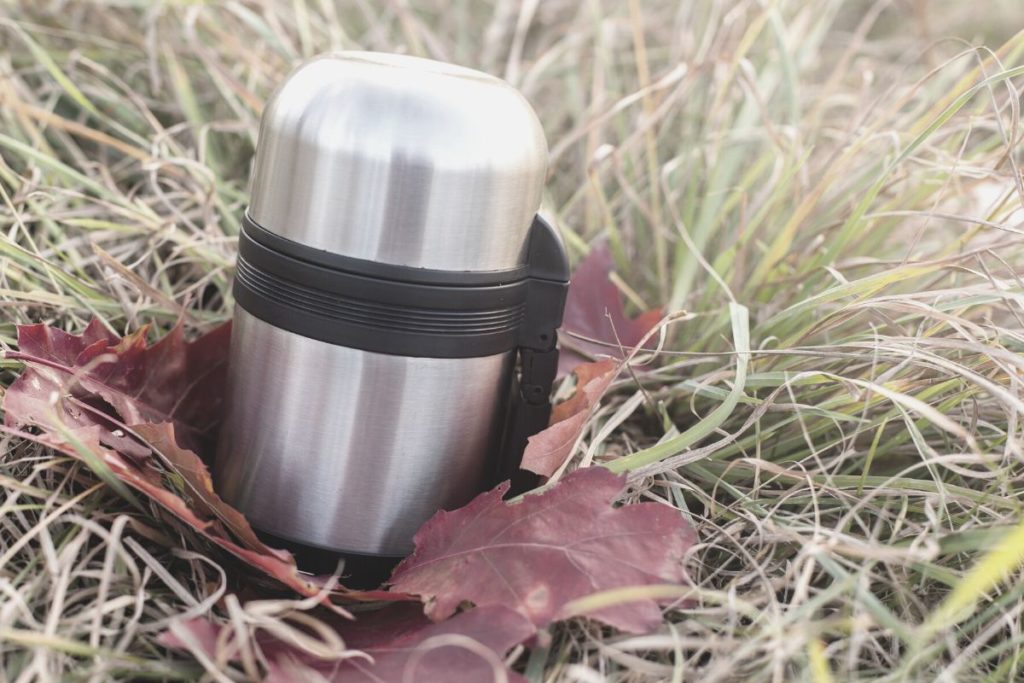
The vacuum insulation technology traps heat to keep hot contents warm in a food flask; thermos tumblers or hot food jars and containers are a great way to retain temperatures and keep your food hot and fresh for a whole day.
If it is your first time using the flask for hot food, go through the frequently asked questions above so you can maximize the time you can store food and keep it safe and of the best quality.
Read Also: 20 Innovative Ways To Keep Food Fresh Longer.
References:
- [1] U.S. Department of Agriculture. (2022) At what temperature do bacteria grow the fastest? Retrieved from https://ask.usda.gov/s/article/At-what-temperature-do-bacteria-grow-the-fastest
- [2] National Health Service (n/d). Can reheating rice cause food poisoning? Retrieved from https://www.nhs.uk/common-health-questions/food-and-diet/can-reheating-rice-cause-food-poisoning/
- [3] U.S. Food and Drug Administration (2022). What You Need to Know About Egg Safety. Retrieved from https://www.fda.gov/food/buy-store-serve-safe-food/what-you-need-know-about-egg-safety
- [4] USDA Food Safety & Inspection Service. Tweet Published on March 29, 2016. Retrieved from https://twitter.com/usdafoodsafety/status/714843374075953153
- [5] THERMOS (n/d). Care And Use Guide. Retrieved from https://s3.amazonaws.com/ally-listings/Thermos/careAndUse/Stainless+King+Mug+%26+Tumbler+Care+and+Use.pdf
